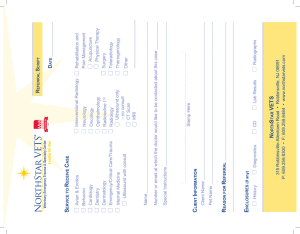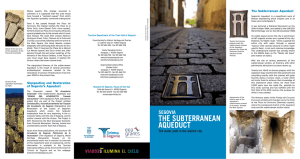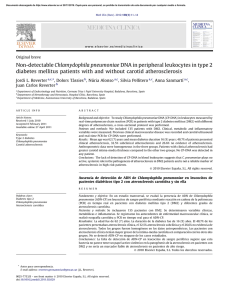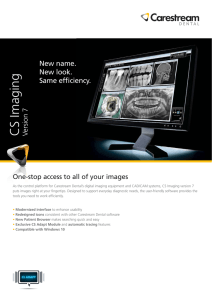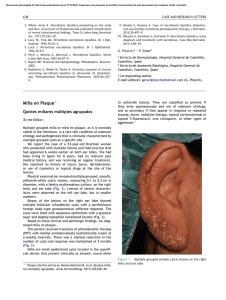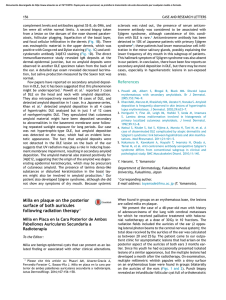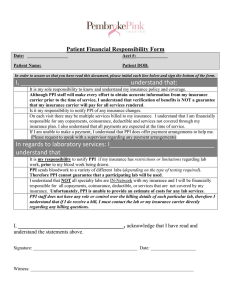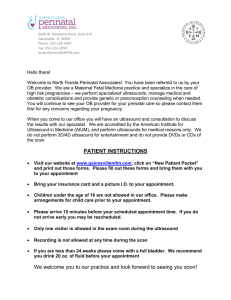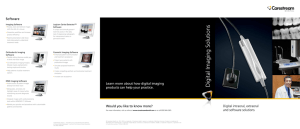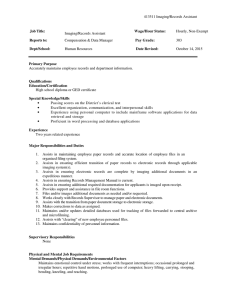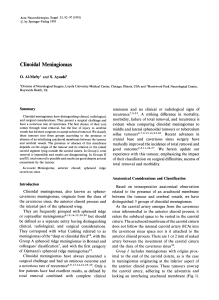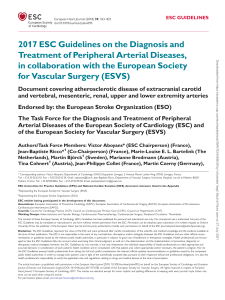Characteristics of Unstable Carotid Plaques – New Image Modalities
Anuncio
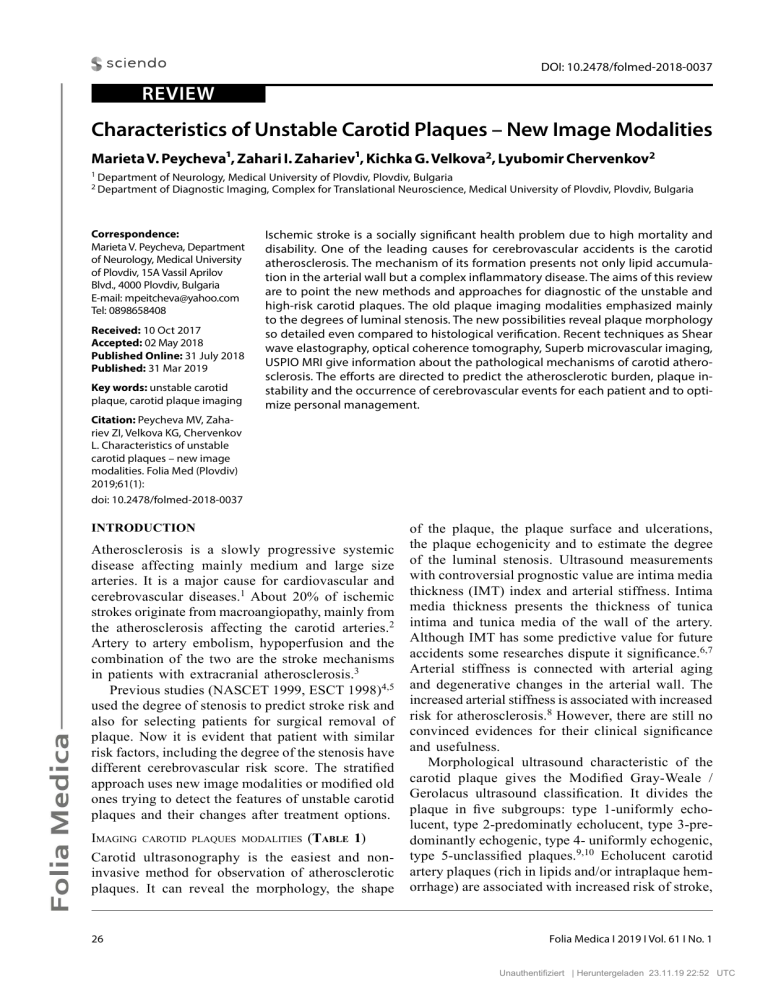
DOI: 10.2478/folmed-2018-0037 REVIEW Characteristics of Unstable Carotid Plaques – New Image Modalities Marieta V. Peycheva¹, Zahari I. Zahariev¹, Kichka G. Velkova2, Lyubomir Chervenkov2 1 Department 2 Department of Neurology, Medical University of Plovdiv, Plovdiv, Bulgaria of Diagnostic Imaging, Complex for Translational Neuroscience, Medical University of Plovdiv, Plovdiv, Bulgaria Correspondence: Marieta V. Peycheva, Department of Neurology, Medical University of Plovdiv, 15A Vassil Aprilov Blvd., 4000 Plovdiv, Bulgaria E-mail: [email protected] Tel: 0898658408 Received: 10 Oct 2017 Accepted: 02 May 2018 Published Online: 31 July 2018 Published: 31 Mar 2019 Key words: unstable carotid plaque, carotid plaque imaging Ischemic stroke is a socially significant health problem due to high mortality and disability. One of the leading causes for cerebrovascular accidents is the carotid atherosclerosis. The mechanism of its formation presents not only lipid accumulation in the arterial wall but a complex inflammatory disease. The aims of this review are to point the new methods and approaches for diagnostic of the unstable and high-risk carotid plaques. The old plaque imaging modalities emphasized mainly to the degrees of luminal stenosis. The new possibilities reveal plaque morphology so detailed even compared to histological verification. Recent techniques as Shear wave elastography, optical coherence tomography, Superb microvascular imaging, USPIO MRI give information about the pathological mechanisms of carotid atherosclerosis. The efforts are directed to predict the atherosclerotic burden, plaque instability and the occurrence of cerebrovascular events for each patient and to optimize personal management. Citation: Peycheva MV, Zahariev ZI, Velkova KG, Chervenkov L. Characteristics of unstable carotid plaques – new image modalities. Folia Med (Plovdiv) 2019;61(1): doi: 10.2478/folmed-2018-0037 INTRODUCTION Atherosclerosis is a slowly progressive systemic disease affecting mainly medium and large size arteries. It is a major cause for cardiovascular and cerebrovascular diseases.1 About 20% of ischemic strokes originate from macroangiopathy, mainly from the atherosclerosis affecting the carotid arteries.2 Artery to artery embolism, hypoperfusion and the combination of the two are the stroke mechanisms in patients with extracranial atherosclerosis.3 Previous studies (NASCET 1999, ESCT 1998)4,5 used the degree of stenosis to predict stroke risk and also for selecting patients for surgical removal of plaque. Now it is evident that patient with similar risk factors, including the degree of the stenosis have different cerebrovascular risk score. The stratified approach uses new image modalities or modified old ones trying to detect the features of unstable carotid plaques and their changes after treatment options. Imaging carotid plaques modalities (Table 1) Carotid ultrasonography is the easiest and noninvasive method for observation of atherosclerotic plaques. It can reveal the morphology, the shape 26 of the plaque, the plaque surface and ulcerations, the plaque echogenicity and to estimate the degree of the luminal stenosis. Ultrasound measurements with controversial prognostic value are intima media thickness (IMT) index and arterial stiffness. Intima media thickness presents the thickness of tunica intima and tunica media of the wall of the artery. Although IMT has some predictive value for future accidents some researches dispute it significance.6,7 Arterial stiffness is connected with arterial aging and degenerative changes in the arterial wall. The increased arterial stiffness is associated with increased risk for atherosclerosis.8 However, there are still no convinced evidences for their clinical significance and usefulness. Morphological ultrasound characteristic of the carotid plaque gives the Modified Gray-Weale / Gerolacus ultrasound classification. It divides the plaque in five subgroups: type 1-uniformly echolucent, type 2-predominatly echolucent, type 3-predominantly echogenic, type 4- uniformly echogenic, type 5-unclassified plaques.9,10 Echolucent carotid artery plaques (rich in lipids and/or intraplaque hemorrhage) are associated with increased risk of stroke, Folia Medica I 2019 I Vol. 61 I No. 1 Unauthentifiziert | Heruntergeladen 23.11.19 22:52 UTC Characteristics of Unstable Carotid Plaques - New Image Modalities Table 1. Advantages and limitations of the different image modalities of carotid plaques Carotid plaques image modalities Advantages Limitations/Disadvantages Ultrasound -visual analysis noninvasive, easily accomplished, realtime measuring limitations connected with the patients, with the pathology and the equipment -computer-aided analysis segmentation of the lumen and patientspecific 3D models accessible only in some laboratories, no official algorithm for daily use grey-scale median measuring the echogenicity of the plaques components limited measurements Shear wave elastography quantifying fibrous cup elasticity limited measurements CT angiography measuring moderate and severe stenosis, distinguish calcification and plaque ulceration ionizing radiation, not useful for mild stenosis, not presenting plaque morphology -visual analysis non-invasive, no ionizing radiation, highly reproducible, present artery wall, distinquish moderate and severe stenosis, present plaque limitations connected with the equipment, contraindications in some patients, time consuming -computer-aided analysis morphology, segmentation of the lumen and patient-specific 3D models Optical coherence tomography can directly visualize and quantify thincap fibroatheroma, intraluminal thrombus, calcified nodules, and vascular inflammation poor tissue penetration, limited measurements Contrast enhanced ultrasound detects the new vessel formations, improves visualization of vessel wall irregularities and provides direct visualization of intraplaque neovascularization not ditecting microvessels, limited measurements Superb microvascular imaging visualization of low microvascular flow, high-resolution image of the minute vessels and low-velocity flows not detecting plaque morphology, limited measurements Positron emission tomography can assess the plaque inflammatory agents and metabolically active cells ionizing radiation, no information about stenosis and plaque morphology MRI independent of the degree of artery stenosis.11-13 Measuring the unstable and vulnerable to rupture plaque can be done by Plaque risk score and the following ultrasound plaque characteristics: echolucent, heterogeneity, plaque irregularity, plaque neovascularization. In their meta analysis Brinjikji W and al. described that echolucency, neovascular- Folia Medica I 2019 I Vol. 61 I No. 1 ization, ulceration and intraplaque motion are the characteristics of symptomatic carotid plaques.14 Computerised evaluation of plaque echogenicity can be done with grey-scale median (GSM). It is B-mode method that measures the echogenicity according the frequency distribution of the grey values within the plaque image. The echogenicity of the 27 Unauthentifiziert | Heruntergeladen 23.11.19 22:52 UTC M. Peycheva et al plaque is divided in three groups. The high GSM values have good correlation with the fibrous tissue and calcium, the low GSM values show good correlation with the lipid core and haemorrhage. Some researches prove that plaques with low GSM values carry greater risk for new strokes.15 Disadvantage of the method is low sensitivity. Atherosclerotic burden is a personal predictive risk factor for future vascular accidents. Information about it can be obtained by the total plaque surface on ultrasound or magnetic resonance images. Three-dimensional ultrasound plaque volume measurement allows semianatomical quantification. The advantages of the method is quick (mean time, 14 minutes), accurate, repeatable, and implementable in a clinical environment and in longitudinal studies.16 Studies reported good intra- and inter-observer reproducibility ranging from 2.8-6.0% to 4.2-7.6%, respectively.17 Still the results are not compared with the standard modalities and there are no criteria for unstable plaques. A novel ultrasound technique for quantifying tissue elasticity is Shear wave elastography (SWE). Elasticity is quantified by using Young’s Modulus (YM) within the plaque and within the vessel wall. Some authors suggest that SWE can predict the rupture of the fibrous cap.18,19 For getting more information it can be joined with other ultrasound techniques as Grey-scale median and Gray-Weale classification.20 According American Heart Association (AHA) the process of plaque formation is divided in the following stages (Table 2).21 Carotid magnetic resonance images (MRI) gives new possibilities to indentify High-risk plaques. It is one of the most promising modalities for visualizing the carotid atherosclerotic plaque. A modified American Heart Association classification (Table 3) based on the magnetic resonance appearance of plaque components is shown to have good correlation between MRI image and histology of the plaque.21 Histopathological studies of carotid plaques have identified key features of high-risk plaques: a thin and ulcerating fibrous cap, lipid-rich necrotic core, inflammation, neovascularization, intraplaque hemorrhage, microcalcifications and cholesterol crystals. Several markers of plaque vulnerability can be identified by MRI: large lipid-rich necrotic core, intra-plaque hemorrhage, surface disruption, inflammation, surface calcified nodules.22 High-resolution magnetic resonance imaging allows direct visualization of the diseased vessel 28 wall, of the plaque morphology and can monitor the progression of the disease.21,23-26 MR imaging is non-invasive, does not involve ionizing radiation, and is highly reproducible.26 Well-established Magnetic resonance (MR) modality for plaque characterization is 1.5T multicontrast MRI. Three basic contrast weightings (T1, PD, T2) in addition to contrast enhancement (CE) of carotid atherosclerosis can give a high-resolution image of the vessel walls and plaque components.27-29 Some studies prove that Contrast-enhanced MR plays an important role for the identification of the lipid-rich necrotic core and the structure of the fibrous cap.27 As local inflammation is very important for the vulnerable carotid plaques there is a MR modality that can observe it. Dynamic contrast-enhanced MRI is a modality that can measure the activity of inflammatory biomarkers in arterial plaques suggested by the increased vascular supply and the disturbed endothelial permeability.26 3T MR carotid image shows significant advantages compared to 1.5T (Fig. 1): improvement in the signal-to-noise ratio, contrast-to-noise ratio, image quality, its ability to reduce scan time and increase spatial resolution.26,30 Some studies validate the 3T MR findings to histological proven 1.5T carotid image criteria and find prospective correlations.30,31 One of the new possibilities of magnetic resonance imaging is the use of USPIO (ultra small iron particles) contrast agents. As it accumulates in activated macrophages this method is used for experimental studies for identification of the inflamed carotid plaques.32 The USPIO MR imaging can also be used for observing the pathological mechanisms of the stroke. In the last years several efforts have been made to obtain better characteristics of the structures of carotid wall and plaques. Visual analysis is the most basic but not enough detailed approach to determine the morphology of the atherosclerotic plaque. Computer-aided methods have been developed for better identification of the carotid lumen and atherosclerotic components. Automatic segmentation of the lumen of the carotid artery is done in ultrasound Bmode images33 and in magnetic resonance images34. Patient-specific 3D luminal surface reconstruction and computer fluid stimulation gives better understanding of the hemodynamic parameters in the place of the plaque.35,36 Image-based computational studies of the carotid plaque gives a noninvasive approach for subject-specific flow analysis. Folia Medica I 2019 I Vol. 61 I No. 1 Unauthentifiziert | Heruntergeladen 23.11.19 22:52 UTC Characteristics of Unstable Carotid Plaques - New Image Modalities Table 2. Conventional American Heart Association Classification of atherosclerotic plaques Type I: initial lesion with foam cells Type V: fibroatheroma Type II: fatty streak with multiple foam cell layers Type VI: complex plaque with possible surface defect, hemorrhage, or thrombus Type III: preatheroma with extracellular lipid pools Type VII: calcified plaque Type IV: atheroma with a confluent extracellular lipid core Type VIII: fibrotic plaque without lipid Core Table 3. Modified AHA Classification for MR image of atherosclerotic plaques Type I–II: near-normal wall thickness, no calcification Type VI: complex plaque with possible surface defect, hemorrhage or thrombus Type III: diffuse intimal thickening or small eccentric plaque with no calcification Type VII: calcified plaque Type IV–V: plaque with a lipid or necrotic core surrounded by fibrous tissue with possible calcification Type VIII: fibrotic plaque without lipid core and with possible small calcification Computed tomography (CT) angiography (Fig. 2) is used for detecting arterial stenosis. It can present moderate and severe stenosis, calcification and plaque ulceration. This image method is quick and easily applicable for carotid stenosis but it includes radiation exposure. Optical coherence tomography (OCT) is a new intravascular modality using near-infrared light (1,300 nm). It provides the highest imaging resolution (10 to 15 μm) of the vascular pathology. With this method it is possible the identification of plaque components such as lipid, calcium, and fibrous tissue.37 In addition, with OCT it can directly visualize and quantify thin-cap fibroatheroma (TCFA), intraluminal thrombus, calcified nodules, and vascular inflammation.38,39 Limitation of the method is poor tissue penetration.40 Neovascularization inside the carotid plaque is consider to be one of the risk factors for plaque hemorrhage and rupture leading to new cerebrovascular accident. These vessels have low-velocity blood flow that makes different to observe with the conventional methods. Contrast enhanced ultrasound (CEUS) is one of the possibility to detect the new vessel formations. The ultrasound contrast agents contain microbubbles (1-8 μm) that resonate when exposed to ultrasound waves. It improves visualization of vessel wall irregularities and provides direct visualization of Folia Medica I 2019 I Vol. 61 I No. 1 intraplaque neovascularization.41 But still it is a challenge for microvessels. Superb microvascular imaging (SMI) is a technology that provides visualization of low microvascular flow never seen before with ultrasound. With smart algorithm it analyzes the small clutter motions and thus result in better and high-resolution image of the minute vessels and low-velocity flows.42 For researches there is an investigation that can give information on molecular level. The Positron emission tomography (PET) can assess the plaque inflammatory agents and metabolically active cells. It is measured by the increased 2-deoxy-2- [18F] fluoro-D-glucose (18F-FDG) uptake. Some studies show correlations with the inflammation, with plaque instability, with the risk of new ischemic events, risk of early stroke recurrence and with poor patient outcome after an incident.42-46 All this new imaging modalities are promising not only for studying the characteristics of the unstable carotid plaque but also to observe the changes of the plaque after medical treatment.47 CONCLUSIONS As carotid atherosclerosis is one of the leading causes for cerebrovascular accidents it is very important to study the mechanisms of its formation and the stages of its transformation and destabilization. The new plaque imaging modalities can identify the 29 Unauthentifiziert | Heruntergeladen 23.11.19 22:52 UTC M. Peycheva et al Figure 1 A. Figure 2 A. Figure 1 B. Figure 2 B. Figure 1 C. Figure 2 C. Figure 1. Severe stenosis of right ICA shown on ultrasound, TOF and T1 black blood MRI (black arrow). 30 Figure 2. Stenosis and calcification of ICA shown on ultrasound and CT angiography. Folia Medica I 2019 I Vol. 61 I No. 1 Unauthentifiziert | Heruntergeladen 23.11.19 22:52 UTC Characteristics of Unstable Carotid Plaques - New Image Modalities high-risk patients and to contribute to the stratified medicine where the patient get the right treatment at the right time. ACKNOWLEDGMENTS This review is part of the research project “Markers of inflammation associated with the nature and instability of plaques in carotid atherosclerosis” funded by Medical University of Plovdiv, Bulgaria. (project code № 04/2015). It is a co-work with the Complex for Translational Neuroscience, Medical University of Plovdiv. REFERENCES 1. Soler EP, Ruiz VC. Epidemiology and risk factors of cerebral ischemia and ischemic heart diseases: similarities and differences. Curr Cardiol Rev 2010;6(3):138-149. 2. Grau AJ, Weimar C, Buggle F, et al. Risk factors, outcome and treatment in subtypes of ischaemic stroke: the German stroke data bank. Stroke 2001;32:2559-66. 3. Wong KS, Caplan LR, Kim JS. Stroke mechanisms. Front Neurol Neurosci 2016;40:58-71. 4. North American Symptomatic Carotid Endarterectomy Trial. Methods, patient characteristics, and progress. Stroke 1991;22:711-20. 5. Randomised trial of endarterectomy for recently symptomatic carotid stenosis: final results of the MRC European Carotid Surgery Trial (ECST). Lancet 1998;351:1379-87. 6. Costanzo P, Perrone-Filardi P, Vassallo E, et al. Does carotid intima-media thickness regression predict reduction of cardiovascular events. A meta-analysis of 41 randomized trials. J Am Coll Cardiol 2010;56 (24):2006-20. 7. Lorenz MW, Polak JF, Kavousi M, et al. Carotid intima-media thickness progression to predict cardiovascular events in the general population (the PROG-IMT collaborative project): a metaanalysis of individual participant data. Lancet 2012; 379(9831):2053-62. 8. van Popele NM, Grobbee DE, Bots ML, et al. Association between arterial stiffness and atherosclerosis. Stroke 2001;32:454-60. 9. Gray-Weale A, Graham JC, Burnett JR, et al. Carotid artery atheroma: comparison of preoperative B-mode ultrasound appearance with carotid endarterectomy specimen pathology. J Cardiovasc Surg 1988;29:676-81. 10. Geroulakos G, Ramaswami G, Nicolaides A, et al. Characterization of symptomatic and asymptomatic carotid plaques using high resolution real-time ultrasonography. Br J Surg 1993;80:1274-7. Folia Medica I 2019 I Vol. 61 I No. 1 11. Skagen K, Skjelland M, Zamani M, et al. Unstable carotid artery plaque: new insights and controversies in diagnostics and treatment. Croat Med J 2016;57:311-20. 12. Mathiesen EB, Joakimsen O, Bonaa KH. Prevalence of and risk factors associated with carotid artery stenosis: the Tromso Study. Cerebrovasc Dis 2001;12:44-51. 13. Polak JF, Shemanski L, O’Leary DH, et al. Hypoechoic plaque at US of the carotid artery: an independent risk factor for incident stroke in adults aged 65 years or older. Cardiovascular Health Study. Radiology 1998;208:649-54. 14. Brinjikji W, Rabinstein AA, Lanzino G. Ultrasound characteristics of symptomatic carotid plaques: a systematic review and meta-analysis. Cerebrovasc Dis 2015;40(3-4):165-174. 15. Nikolaides A, Kakkos S, Griffin M, et al. Asymptomatic Carotid Stenosis and Risk of Stroke (ACSRS) Study Group. Severity of asymptomatic carotid stenosis and risk of ipsilateral hemispheric ischaemic events: results from the ACSRS study. Eur J Vasc Endovasc Surg 2005;30:275-84. 16. Khan AA, Koudelka C, Goldstein C, et al. Semiautomatic quantification of carotid plaque volume with three-dimensional ultrasound imaging. J Vasc Surg 2017;65(5):1407-17. 17. Makris GC, Lavida A, Griffin M, et al. Threedimensional ultrasound imaging for the evaluation of carotid atherosclerosis. Atherosclerosis 2011;219(2):377-83. 18. Richards MS, Perucchio R, Doyley MM. Visualizing the stress distribution within vascular tissues using intravascular ultrasound elastography: a preliminary investigation. Ultrasound Med Biol 2015;41:1616-31. 19. Garrard JW, Ummur P, Nduwayo S, et al. Shear wave elastography may be superior to greyscale median for the identification of carotid plaque vulnerability: a comparison with histology. Ultraschall Med 2015;36:386-90. 20. Ramnarine KV, Garrard JW, Kanber B, et al. Shear wave elastography imaging of carotid plaques: feasible, reproducible and of clinical potential. Cardiovasc Ultrasound 2014;12:49. 21. Cai JM, Hatsukami TS, Ferguson MS, et al. Classification of human carotid atherosclerotic lesions with in vivo multicontrast magnetic resonance imaging. Circulation 2002;106:1368-73. 22. Osborn EA, Jaffer FA. Imaging atherosclerosis and risk of plaque rupture. Curr Atheroscler Rep 2013;15(10):359. 23. Toussaint JF, LaMuraglia GM, Southern JF, et al. Magnetic resonance images lipid, fibrous, calcified, 31 Unauthentifiziert | Heruntergeladen 23.11.19 22:52 UTC M. Peycheva et al hemorrhagic, and thrombotic components of human atherosclerosis in vivo. Circulation 1996;94:932-8. 24. Clarke SE, Hammond RR, Mitchell JR, et al. Quantitative assessment of carotid plaque composition using multicontrast MRI and registered histology. Magn Reson Med 2003;50:1199-208. 25. Hatsukami TS, Ross R, Polissar NL, et al. Visualization of fibrous cap thickness and rupture in human atherosclerotic carotid plaque in vivo with highresolution magnetic resonance imaging. Circulation 2000;102:959-64. 26. Yuan C, Oikawa M, Miller Z, et al. MRI of carotid atherosclerosis. J Nucl Cardiol 2008;15(2):266-75. 27. Cai J, Hatsukami TS, Ferguson MS, et al. In vivo quantitative measurement of intact fibrous cap and lipid-rich necrotic core size in atherosclerotic carotid plaque: comparison of high-resolution, contrastenhanced magnetic resonance imaging and histology. Circulation 2005;112(22):3437-44. 28. Takaya N, Cai J, Ferguson MS, et al. Intra- and inter-reader reproducibility of magnetic resonance imaging for quantifying the lipid-rich necrotic core is improved with gadolinium contrast enhancement. J Magn Reson Imaging 2006;24:203-10. 29. Yuan C, Kerwin WS, Ferguson MS, et al. Contrast enhanced high resolution MRI for atherosclerotic carotid artery tissue characterization. J Magn Reson Imaging 2002;15:62-67. 30. Yarnykh VL, Terashima M, Hayes CE, et al. Multicontrast black-blood MRI of carotid arteries: comparison between 1.5 and 3 tesla magnetic field strengths. J Magn Reson Imaging 2006;23(5):691-8. 31. Underhill HR, Yarnykh VL, Hatsukami TS, et al. Carotid plaque morphology and composition: initial comparison between 1.5- and 3.0-T magnetic field strengths. Radiology 2008;248(2):550-60. 32. Trivedi RA, Mallawarachi C, U-King-Im JM, et al. Identifying inflamed carotid plaques using in vivo USPIO-enhanced MR imaging to label plaque macrophages. Arterioscler Thromb Vasc Biol 2006;26(7):1601-6. 33. Santos AM, dos Santos RM, Castro PM, et al. A novel automatic algorithm for the segmentation of the lumen of the carotid artery in ultrasound B-mode images. Expert Systems with Application 2013;40:6570-9. 34. Jodas DS, Pereira AS, Tavares JMRS. Automatic segmentation of the lumen in magnetic resonance images of the carotid artery. In: Tavares J, Natal JR, editors. VipIMAGE. ECCOMAS. Lecture Notes in Computational Vision and Biomechanics, Springer, Cham. 2017;27. 32 35. Sousa LC, Castro CF, António CC, et al. Toward hemodynamic diagnosis of carotid artery stenosis based on ultrasound image data and computational modeling. Med Biol Eng Comput 2014;52:11:971‑83. 36. Sousa L, Castro C, António C, et al. Haemodynamic conditions of patient-specific carotid bifurcation based on ultrasound imaging. Computer Methods in Biomechanics and Biomedical Engineering: Imaging & Visualization 2014;2:3:157-66. 37. Kume T, Akasaka T, Kawamoto T, et al. Assessment of coronary arterial plaque by optical coherence tomography. Am J Cardiol 2006;97:1172-5. 38. Kume T, Okura H, Kawamoto T, et al. Assessment of the coronary calcification by optical coherence tomography. EuroIntervention 2011;6:768-72. 39. Jones MR, Attizzani GF, Given CA 2nd, et al. Intravascular frequency-domain optical coherence tomography assessment of carotid artery disease in symptomatic and asymptomatic patients. JACC Cardiovasc Interv 2014;7(6):674-84. 40. Kataoka Y, Nicolls S. Residual risk and biology of the disease: Implications for plaque imaging. In: Nichols S, Crowe T, eds. Imaging coronary atherosclerosis. New York: Springer; 2014:1-21. 41. Partovi S, Loebe M, Aschwanden M, et al. Contrastenhanced ultrasound for assessing carotid atherosclerotic plaque lesions. AJR Am J Roentgenol 2012;198(1):W13-9. 42. Zamani M SK, Skjelland M, Russell D. The assessment of neovascularization in carotid artery plaques and ischemic stroke using Superb Microvascular Imaging. International Journal of Stroke 2015;10 (Attachment 3). 43. Graebe M, Pedersen SF, Borgwardt L, et al. Molecular pathology in vulnerable carotid plaques: correlation with [18]-fluorodeoxyglucose positron emission tomography (FDG-PET). Eur J Vasc Endovasc Surg 2009;37:714-21. 44. Chroinin DN, Marnane M, Akijian L, et al. Serum lipids associated with inflammation-related PETFDG uptake in symptomatic carotid plaque. Neurology 2014;82:1693-9. 45. Figueroa AL, Abdelbaky A, Truong QA, et al. Measurement of arterial activity on routine FDG PET/ CT images improves prediction of risk of future CV events. JACC Cardiovasc Imaging 2013;6:1250-9. 46. Marnane M, Merwick A, Sheehan OC, et al. Carotid plaque inflammation on 18F-fluorodeoxyglucose positron emission tomography predicts early stroke recurrence. Ann Neurol 2012;71:709-18. 47. Yuan C, Kerwin WS, Yarnykh VL, et al. MRI of atherosclerosis in clinical trials. NMR Biomed 2006;19:636-54. Folia Medica I 2019 I Vol. 61 I No. 1 Unauthentifiziert | Heruntergeladen 23.11.19 22:52 UTC Characteristics of Unstable Carotid Plaques - New Image Modalities Характеристики нестабильных бляшек каротидных артерий - новые способы изображения Мариета В. Пейчева1, Захари И. Захариев1, Кичка Г. Велкова2, Любомир Червенков2 1 Кафедра неврологии, Медицинский университет - Пловдив, Пловдив, Болгария Кафедра образной диагностики, Комплекс трансляционной нейронауки, Медицинский университет -Пловдив, Пловдив, Болгария 2 Адрес для корреспонденции: Мариета В. Пейчева, Кафедра неврологии, Медицинский университет - Пловдив, бул. „Васил Априлов“ № 15 А, 4000, Пловдив, Болгария E-mail: [email protected] Tel: 0898658408 Дата получения: 10 октября 2017 Дата приемки: 02 мая 2018 Дата онлайн публикации: 31 июля 2018 Дата публикации: 31 марта 2019 Ключевые слова: unstable carotid plaque, carotid plaque imaging Ишемический инсульт является социально значимой проблемой здравоохранения из-за высокой смертности и травм, которые он вызывает. Одной из основных причин цереброваскулярных осложнений является атеросклероз каротидных артерий. Механизм его образования заключается не только в накоплении липидов в стенке артерии, но и в комплексном воспалительном заболевании. Целями данного обзора являются выявление новых методов и подходов для диагностики нестабильных и опасных бляшек каротидных артерий. Старые методы визуализации бляшек делают акцент в основном на уровнях люменального стеноза. Новые возможности раскрывают морфологию бляшки в таких деталях, которые даже сопоставимы с гистологическим исследованием. Современные методы, такие как эластография сдвиговой волны, оптическая когерентная томография, превосходная микрососудистая томография и контрастная MPТ с применением лимфотропных наночастиц (USPIO MRI), предоставляют информацию о патологических механизмах атеросклероза каротидных артерий. Усилия направлены на прогнозирование атеросклеротического бремени, нестабильности бляшек и проявления цереброваскулярных событий для каждого пациента и оптимизацию персонального проведения лечения. Образец цитирования: Peycheva MV, Zahariev ZI, Velkova KG, Chervenkov L. Characteristics of unstable carotid plaques – new image modalities. Folia Med (Plovdiv) 2019;61(1): doi: 10.2478/folmed-2018-0037 Folia Medica I 2019 I Vol. 61 I No. 1 33 Unauthentifiziert | Heruntergeladen 23.11.19 22:52 UTC
